Unit 3 Could you please tell me where the restrooms are? 单元知识学案
文档属性
| 名称 | Unit 3 Could you please tell me where the restrooms are? 单元知识学案 | 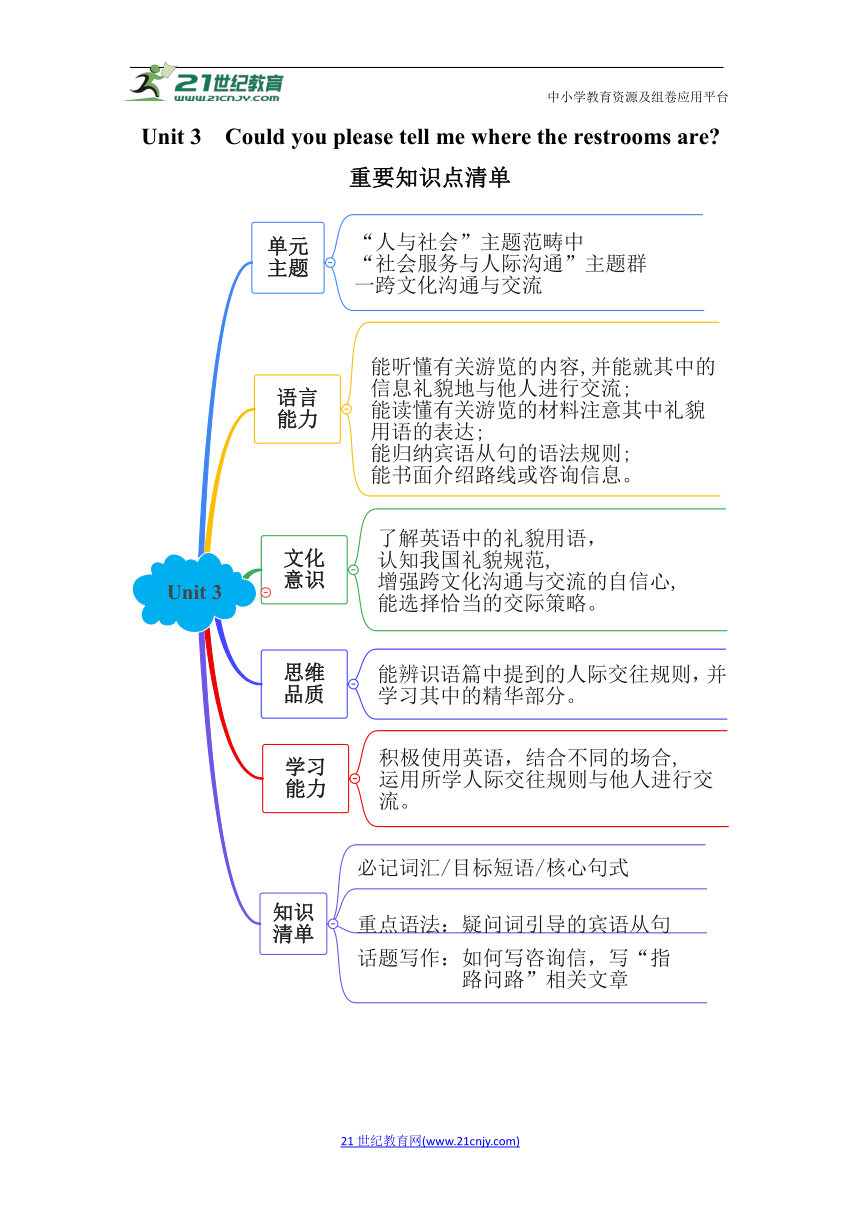 | |
| 格式 | docx | ||
| 文件大小 | 789.2KB | ||
| 资源类型 | 试卷 | ||
| 版本资源 | 人教新目标(Go for it)版 | ||
| 科目 | 英语 | ||
| 更新时间 | 2023-10-12 22:43:02 | ||
图片预览

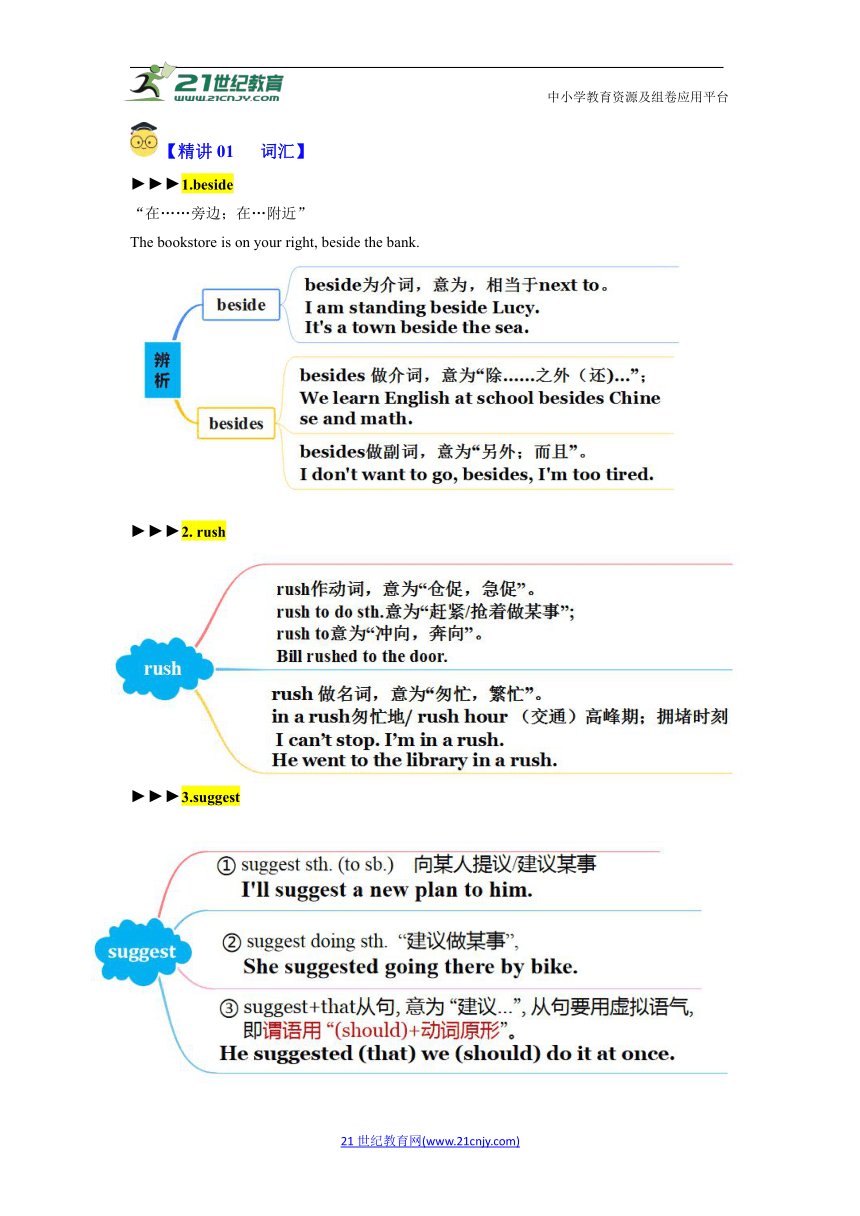
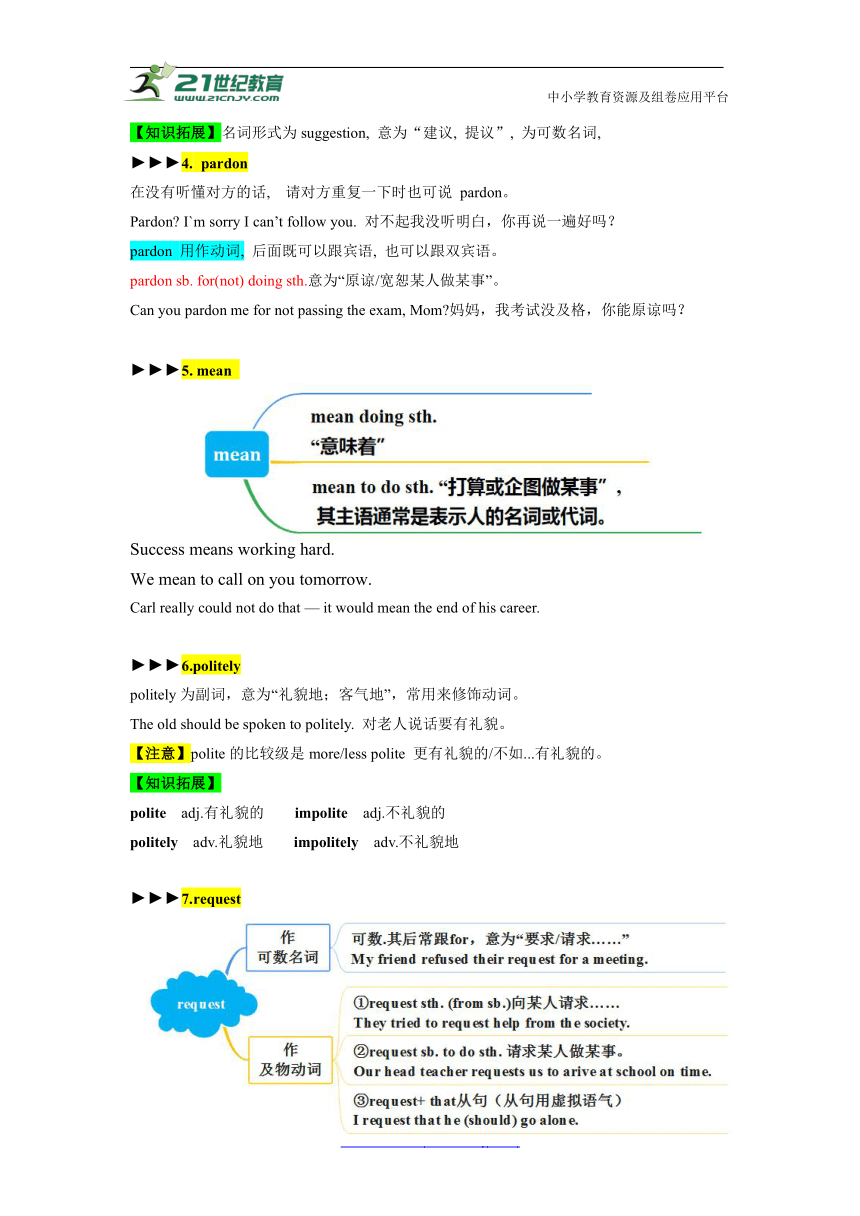
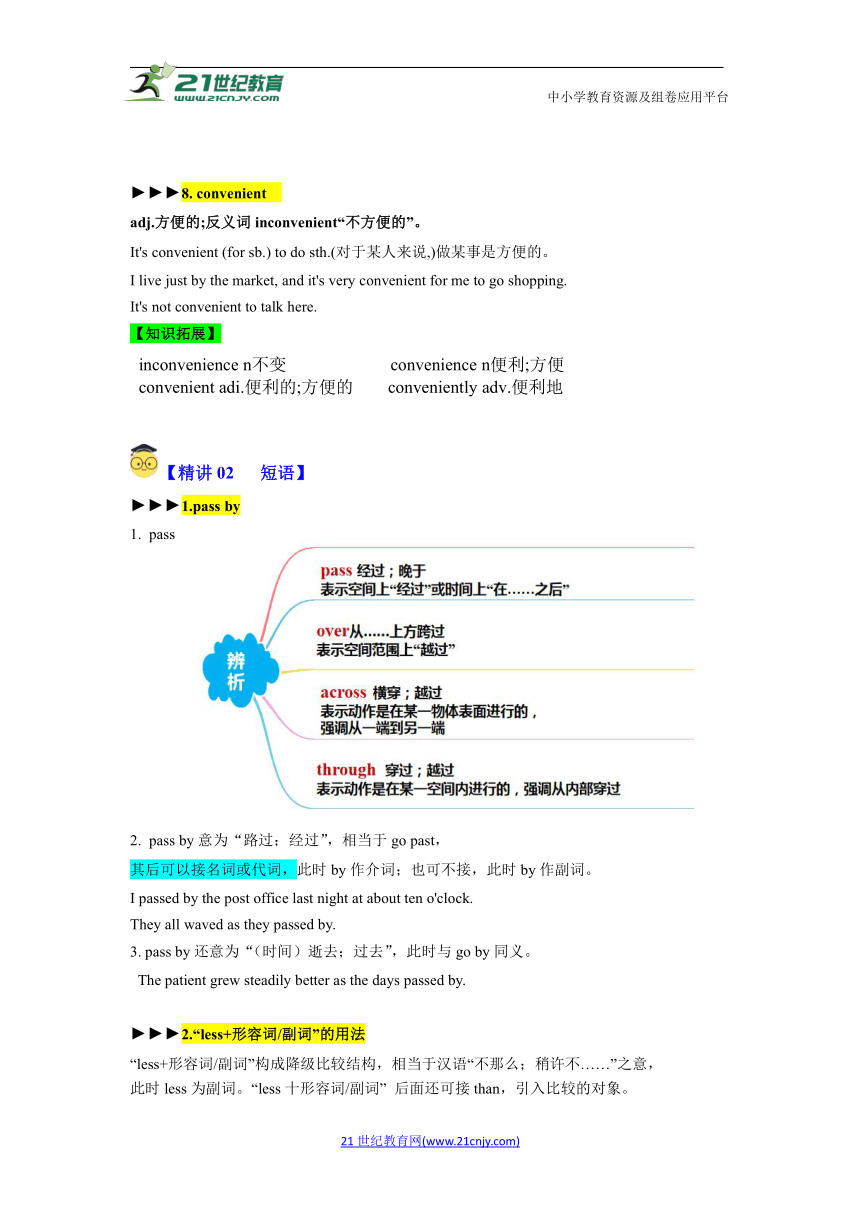
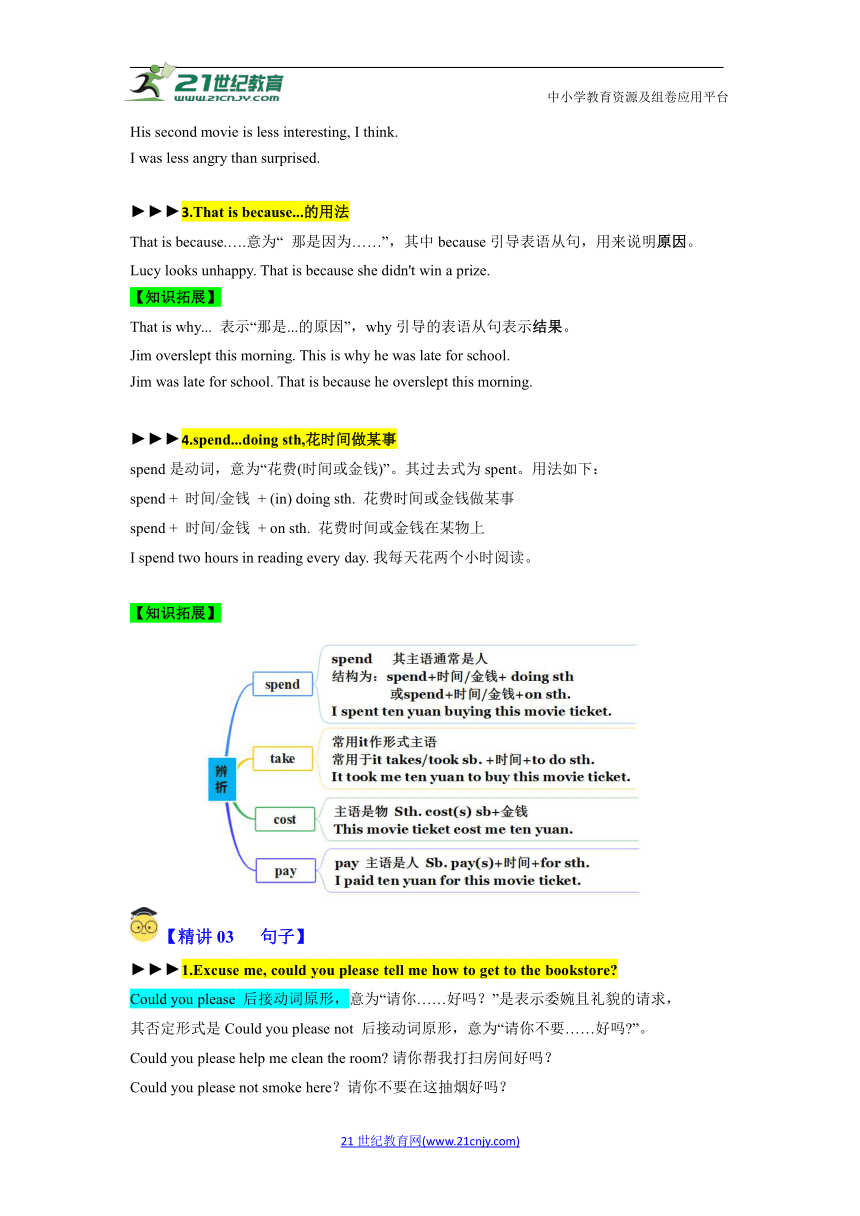
文档简介
中小学教育资源及组卷应用平台
Unit 3 Could you please tell me where the restrooms are
(
Unit 3
单元
主题
语言
能力
能听懂有关游览的内容,并能就其中的信息礼貌地与他人进行交流;
能读懂有关游览的材料注意其中礼貌用语的表达;
能归纳宾语从句的语法规则;
能书面介绍
路线或咨询信息
。
“人与社会”主题范畴中
“社会服务与人际沟通”主题群
一跨文化沟通与交流
文化
意识
了解英语中的礼貌用语,
认知我国礼貌规范,
增强跨文化沟通与交流的自信心,
能选择恰当的交际策略。
思维
品质
能辨识语篇中提到的人际交往规则,并学习其中的精华部分。
学习
能力
积极使用英语,结合不同的场合,
运用所学人际交往规则与他人进行交流。
知识
清单
必记词汇/目标短语/核心句式
重点语法:疑问词引导的宾语从句
话题写作:如何写咨询信,写“指
路问路”相关文章
)重要知识点清单
(北京)股份有限公司
【精讲01 词汇】
1.beside
“在……旁边;在…附近”
The bookstore is on your right, beside the bank.
2. rush
3.suggest
【知识拓展】名词形式为suggestion, 意为“建议, 提议”, 为可数名词,
4. pardon
在没有听懂对方的话, 请对方重复一下时也可说 pardon。
Pardon I`m sorry I can’t follow you. 对不起我没听明白,你再说一遍好吗?
pardon 用作动词, 后面既可以跟宾语, 也可以跟双宾语。
pardon sb. for(not) doing sth.意为“原谅/宽恕某人做某事”。
Can you pardon me for not passing the exam, Mom 妈妈,我考试没及格,你能原谅吗?
5. mean
Success means working hard.
We mean to call on you tomorrow.
Carl really could not do that — it would mean the end of his career.
6.politely
politely为副词,意为“礼貌地;客气地”,常用来修饰动词。
The old should be spoken to politely. 对老人说话要有礼貌。
【注意】polite的比较级是more/less polite 更有礼貌的/不如...有礼貌的。
【知识拓展】
polite adj.有礼貌的 impolite adj.不礼貌的
politely adv.礼貌地 impolitely adv.不礼貌地
7.request
8. convenient
adj.方便的;反义词inconvenient“不方便的”。
It's convenient (for sb.) to do sth.(对于某人来说,)做某事是方便的。
I live just by the market, and it's very convenient for me to go shopping.
It's not convenient to talk here.
【知识拓展】
inconvenience n不变 convenience n便利;方便
convenient adi.便利的;方便的 conveniently adv.便利地
【精讲02 短语】
1.pass by
pass
pass by意为“路过;经过”,相当于go past,
其后可以接名词或代词,此时by作介词;也可不接,此时by作副词。
I passed by the post office last night at about ten o'clock.
They all waved as they passed by.
3. pass by还意为“(时间)逝去;过去”,此时与go by同义。
The patient grew steadily better as the days passed by.
2.“less+形容词/副词”的用法
“less+形容词/副词”构成降级比较结构,相当于汉语“不那么;稍许不……”之意,
此时less为副词。“less十形容词/副词” 后面还可接than,引入比较的对象。
His second movie is less interesting, I think.
I was less angry than surprised.
3.That is because...的用法
That is because.….意为“ 那是因为……”,其中because引导表语从句,用来说明原因。
Lucy looks unhappy. That is because she didn't win a prize.
【知识拓展】
That is why... 表示“那是...的原因”,why引导的表语从句表示结果。
Jim overslept this morning. This is why he was late for school.
Jim was late for school. That is because he overslept this morning.
4.spend...doing sth,花时间做某事
spend是动词,意为“花费(时间或金钱)”。其过去式为spent。用法如下:
spend + 时间/金钱 + (in) doing sth. 花费时间或金钱做某事
spend + 时间/金钱 + on sth. 花费时间或金钱在某物上
I spend two hours in reading every day. 我每天花两个小时阅读。
【知识拓展】
【精讲03 句子】
1.Excuse me, could you please tell me how to get to the bookstore
Could you please 后接动词原形,意为“请你……好吗?”是表示委婉且礼貌的请求,
其否定形式是Could you please not 后接动词原形,意为“请你不要……好吗 ”。
Could you please help me clean the room 请你帮我打扫房间好吗?
Could you please not smoke here?请你不要在这抽烟好吗?
肯定回答:Sure./ Certainly./Of course./No problem./Yes, please.等。
否定回答:Sorry,I can’t. I have to…/ I’d love to, but I have to...否定回答要礼貌地说明理由。
【注意】
Could you…?句型的回答中,回答中不用could,用can。
这里could不表示过去时态,只表示语气委婉。
【知识拓展】
2. I was scared at first, but shouting did help.
do表示强调的用法
助动词do放在动词前面表示强调,随主语的人称、数和句子的时态变化而变化。
did在此处为助动词,在句中起强调作用,用来表达说话者强烈的感情。
这里did要重读,后接动词原形,意为“的确,确实,真的”。
Please do be quiet for a moment.
—Sorry, Mr Smith. I leave my English book at home.
—That’s OK, but do remember to put away your things before sleep.
3. It might seem more difficult to speak politely than be direct.
此处it是形式主语,真正的主语是后面的动词不定式。
句型可概括为:主语+seem+(to be)+表语。
Mr. Black seemed (to be) quite happy.布莱克先生好像十分快乐。
【知识拓展】
3. The expressions they use might depend on whom they are speaking to or how well they know each other.
此句是多重复合句,本句包含了一个定语从句和两个宾语从句。they use是省略which/that的定语从句,修饰先行词The expressions。宾语从句whom they are speaking to 和 how well they know each other并列做谓语 depend on的宾语。
whom的用法
whom为代词,意为“谁;什么人”,是who的宾格;
口语中多数情况下用who代替whom,
若紧跟介词之后只能用whom。
With whom did you go on a vacation last month
Who did you go on a vacation with last month
whom做关系代词,在定语从句中做宾语,代替先行词(人)。
Do you know the man whom she is talking with
【精讲04 语法】特殊疑问词引导的宾语从句
1.宾语从句连接词(wh-)
当宾语从句是特殊疑问句时,疑问词就是宾语从句的引导词。
连接代词who,whom,whose,which,what
和连接副词where, how, why, when可引导宾语从句,并在从句中做一定成分。
词类 词汇 中文含义 在句中的功能
连接代词 who 谁(主格) 除在句中起连接作用外,还在宾语从句中做主语、宾语、定语或表语。
whom 谁(宾格)
whose 谁的(所有格)
what 什么
which 哪个
连接副词 when 什么时候 除在句中起连接作用外,还在宾语从句中做状语,不能省略。
where 什么地方;哪里
how 怎样;如何
why 为什么,...的原因
Do you know who will come this afternoon (who在宾语从句中做主语)
She asked whose hair band that was.(whose在宾语从句中做定语)
I want to know when the plane will take off.(when在宾语从句中做状语)
Did you hear what she said (what在宾语从句中做宾语)
Please explain why you were late for class again.(why在宾语从句中做状语)
【注意】 how与某些形容词或副词构成的词组也可以引导宾语从句,
主要有how old, how many, how much, how long, how often, how far等。
He didn't tell me how long he would stay there.
2.宾语从句语序
在含有宾语从句的复合句中,无论主句是陈述句还是疑问句,
宾语从句都必须使用陈述语序,
即“主句十引导词十宾语从句(主语+谓语+其他)”。
因此,当特殊疑问句做宾语从句时,一定要注意语序。
“When will we start ” I wonder. →I wonder when we will start.
When will the sports meeting begin → Can you tell me when the sports meeting will begin?
--- Judy, could you tell me where you bought the schoolbag
--- Oh, yes. I bought it in a store on the Internet.
3.宾语从句可转化成“疑问词十动词不定式”结构
如果从句的主语与主句的主语或主句的宾语一致,
则由疑问词引导的宾语从句可以转化为“疑问词+动词不定式”结构。
I'm not sure when I can turn off the light. = I'm not sure when to turn off the light.
She doesn’t know where she can park her car. = She doesn’t know where to park her car.
4.宾语从句时态
1)若主句是一般现在时,从句用任何所需时态。
2)若主句是一般过去时,从句则用跟过去相关的时态。
3)当宾语从句是表达客观真理和规律的句子,其时态用一般现在时。
【精讲05 写作】
1.话题分析
本单元话题围绕“出行游览”展开,要求我们能够根据不同的情景,得体地运用礼貌语句指路、问路、咨询信息等。
与此相关的写作任务是:
1.能够根据图示或文字提示简单介绍去某地的路线;
2.咨询某些问题的相关信息(咨询信)等。
体裁:应用文(电子邮件、书信);主体部分为说明文
时态:用一般现在时
人称:第一人称。
2.佳句荟萃
问路常用句型
Excuse me, how can I get to....
Excuse me, could you tell me the way to....
Could you tell me how I can get to....
Could you tell me how to get to....
Could you tell me where is.....
Excuse me, which is the way to.....
Excuse me, is there a/an....... near here
指路常用句型
1. The post office is between the factory and the hotel. 邮局在工厂和旅馆之间。
2. It's next to Zhongshan Park. 它在中山公园隔壁。
3. You'd better take No. 92. 你最好乘92路车。
4. It's about ten minutes' walk. 步行大约要十分钟。
5. It's about 700 metres from here.离这儿大约有700米。
6.Walk along the road, and turn to the left at the third turning. 沿着这条路走,在第三个拐弯处向左拐。
7. Go straight down / along this street. 沿着这条街一直走。
8. Turn left at the second turning. 在第二个路口向左转。
9. You will find it on your right. 你会在你右手边发现它。
10.You’d better take a bus. 你最好坐公交车去。(You’d better+动词原形)
11.Take along with this street,and ……is on you left.
12.Go down this way, and turn left at the first crossing,and you 'll find ……is right there, on your left.
13.……is behind(near,next to,on the left of)……
14.You can just take NO.111 bus, and get off at the second station.And you 'll see it.
15.……is in front of us far away,right there!
3.咨询信写作指导
【典例分析】
1.假如你是卡尔(Carl),你的笔友莉萨(Lisa)要来你所在的城市游学,你邀请她来你家里做客。根据下图写信告诉她如何从公共汽车站到你家。词数:80左右。
________________________________________________________________________________________________________________________________________________________________________________________________________________________________________________________________________________________________________________________________________________________________________________________________________________________________________________________________________________________________________________________________________________________________________________________________________________________________________________________
【答案】例文
Dear Lisa,
I know you are arriving here next Friday. Now let me tell you the way to my house. Take a taxi from the bus station. Go down Garden Street. When you see a post office on your left, turn right to Center Street. Go straight down Center Street. You pass a hotel and a bank on your right. When you pass a school on your left, turn left and you can see my house at the end of the street.
I hope you’ll have a good trip.
Yours,
Carl
[总体分析]
①题材:本文是一篇应用文。
②时态:本文以一般现在时为主。
③提示:考生应注意仔细观察所给地图,描述好路线,并适当增加细节,突出写作重点。
[写作步骤]
①第一步,表明得知要来的信息,并点名主题:告诉你路线。
②第二步,详细描述如何从公共汽车站到家里的路线。
③第三步,总结全文,祝福她旅行愉快。
[亮点词汇]
①the way to到……的路
②at the end of在……的尽头/结尾
③have a good trip旅行愉快
[高分句型]
①When you see a post office on your left, turn right to Center Street. (when引导时间状语从句)
②I hope you’ll have a good trip. (省略that的宾语从句)
2.假如你是李华, 你的朋友Clark将来滨州。到滨州后, 你计划带他去参观滨州市博物馆。请你根据以下提示给 Clark写一封电子邮件告知其相关信息。
1. 简介:建于2015年,馆藏丰富,可以品味当地文化与传统艺术。 2. 开放时间:周一全天闭馆周二至周日9: 00—17: 00 3. 入场:免费 4. 注意事项: 5. 博物馆网址:http://www.
要求:
1. 包含提示中所有信息,并适当发挥;
2. 文中不得出现真实姓名与校名;
3. 卷面整洁,书写美观,可适当加2-3分
4. 80词左右,开头与结尾已给出,不计入总词数。
提示词∶品味enjoy;展品exhibition;展览:on display
Dear Clark,
I am happy to know that you are coming to Binzhou! I’d like to take you to visit Binzhou Museum. ________________________________________________________________________________________________________________________________________________________________________________________________________________________________________________________________________________________________________________________________________________________________________________________________________________________________________________________________________________________________________________________________________________________________________
Best wishes,
Li Hua
【答案】例文:
Dear Clark,
I am happy to know that you are coming to Binzhou! I’d like to take you to visit Binzhou Museum.
Binzhou Museum was built in 2015. There are many kinds of exhibitions on display, so it’s a good place to enjoy the local culture and traditional art. We can go there from Tuesday to Sunday. It is open from 9 a. m. to 5 p. m. , but it is closed all day on Monday.
One great thing is that it is free to visit the museum! While visiting the museum, we must follow some rules, such as being quiet, no smoking and no pets. Besides, we are not allowed to take photos in order to protect the exhibitions. If you want to get more information, please visit http:/www, .
Best wishes,
Li Hua
【详解】
题干解读:
该题目是书信类书面表达,根据题目内容完成电子邮件,短文的开头和结尾已经给出,补充剩余内容即可。
例文点评:
例文采用四段式结构,第一段提出想要带克拉克参观滨州博物馆,第二段介绍了滨州博物馆的相关信息,第三段介绍了参观博物馆时的注意事项,第四段结尾,向对方表示祝愿;整篇文章内容完整,结构清晰条理;人称主要是第一人称和第三人称,时态主要是一般现在时。
3.高分亮点:
短语:
be happy to do sth.;would like to do sth.;from…to…;follow rules;such as;take photos;in order to do sth.。
句型:
Binzhou Museum was built in 2015. 一般过去时的被动语态was done;There are many kinds of exhibitions on display. there be句型。
21世纪教育网(www.21cnjy.com)
Unit 3 Could you please tell me where the restrooms are
(
Unit 3
单元
主题
语言
能力
能听懂有关游览的内容,并能就其中的信息礼貌地与他人进行交流;
能读懂有关游览的材料注意其中礼貌用语的表达;
能归纳宾语从句的语法规则;
能书面介绍
路线或咨询信息
。
“人与社会”主题范畴中
“社会服务与人际沟通”主题群
一跨文化沟通与交流
文化
意识
了解英语中的礼貌用语,
认知我国礼貌规范,
增强跨文化沟通与交流的自信心,
能选择恰当的交际策略。
思维
品质
能辨识语篇中提到的人际交往规则,并学习其中的精华部分。
学习
能力
积极使用英语,结合不同的场合,
运用所学人际交往规则与他人进行交流。
知识
清单
必记词汇/目标短语/核心句式
重点语法:疑问词引导的宾语从句
话题写作:如何写咨询信,写“指
路问路”相关文章
)重要知识点清单
(北京)股份有限公司
【精讲01 词汇】
1.beside
“在……旁边;在…附近”
The bookstore is on your right, beside the bank.
2. rush
3.suggest
【知识拓展】名词形式为suggestion, 意为“建议, 提议”, 为可数名词,
4. pardon
在没有听懂对方的话, 请对方重复一下时也可说 pardon。
Pardon I`m sorry I can’t follow you. 对不起我没听明白,你再说一遍好吗?
pardon 用作动词, 后面既可以跟宾语, 也可以跟双宾语。
pardon sb. for(not) doing sth.意为“原谅/宽恕某人做某事”。
Can you pardon me for not passing the exam, Mom 妈妈,我考试没及格,你能原谅吗?
5. mean
Success means working hard.
We mean to call on you tomorrow.
Carl really could not do that — it would mean the end of his career.
6.politely
politely为副词,意为“礼貌地;客气地”,常用来修饰动词。
The old should be spoken to politely. 对老人说话要有礼貌。
【注意】polite的比较级是more/less polite 更有礼貌的/不如...有礼貌的。
【知识拓展】
polite adj.有礼貌的 impolite adj.不礼貌的
politely adv.礼貌地 impolitely adv.不礼貌地
7.request
8. convenient
adj.方便的;反义词inconvenient“不方便的”。
It's convenient (for sb.) to do sth.(对于某人来说,)做某事是方便的。
I live just by the market, and it's very convenient for me to go shopping.
It's not convenient to talk here.
【知识拓展】
inconvenience n不变 convenience n便利;方便
convenient adi.便利的;方便的 conveniently adv.便利地
【精讲02 短语】
1.pass by
pass
pass by意为“路过;经过”,相当于go past,
其后可以接名词或代词,此时by作介词;也可不接,此时by作副词。
I passed by the post office last night at about ten o'clock.
They all waved as they passed by.
3. pass by还意为“(时间)逝去;过去”,此时与go by同义。
The patient grew steadily better as the days passed by.
2.“less+形容词/副词”的用法
“less+形容词/副词”构成降级比较结构,相当于汉语“不那么;稍许不……”之意,
此时less为副词。“less十形容词/副词” 后面还可接than,引入比较的对象。
His second movie is less interesting, I think.
I was less angry than surprised.
3.That is because...的用法
That is because.….意为“ 那是因为……”,其中because引导表语从句,用来说明原因。
Lucy looks unhappy. That is because she didn't win a prize.
【知识拓展】
That is why... 表示“那是...的原因”,why引导的表语从句表示结果。
Jim overslept this morning. This is why he was late for school.
Jim was late for school. That is because he overslept this morning.
4.spend...doing sth,花时间做某事
spend是动词,意为“花费(时间或金钱)”。其过去式为spent。用法如下:
spend + 时间/金钱 + (in) doing sth. 花费时间或金钱做某事
spend + 时间/金钱 + on sth. 花费时间或金钱在某物上
I spend two hours in reading every day. 我每天花两个小时阅读。
【知识拓展】
【精讲03 句子】
1.Excuse me, could you please tell me how to get to the bookstore
Could you please 后接动词原形,意为“请你……好吗?”是表示委婉且礼貌的请求,
其否定形式是Could you please not 后接动词原形,意为“请你不要……好吗 ”。
Could you please help me clean the room 请你帮我打扫房间好吗?
Could you please not smoke here?请你不要在这抽烟好吗?
肯定回答:Sure./ Certainly./Of course./No problem./Yes, please.等。
否定回答:Sorry,I can’t. I have to…/ I’d love to, but I have to...否定回答要礼貌地说明理由。
【注意】
Could you…?句型的回答中,回答中不用could,用can。
这里could不表示过去时态,只表示语气委婉。
【知识拓展】
2. I was scared at first, but shouting did help.
do表示强调的用法
助动词do放在动词前面表示强调,随主语的人称、数和句子的时态变化而变化。
did在此处为助动词,在句中起强调作用,用来表达说话者强烈的感情。
这里did要重读,后接动词原形,意为“的确,确实,真的”。
Please do be quiet for a moment.
—Sorry, Mr Smith. I leave my English book at home.
—That’s OK, but do remember to put away your things before sleep.
3. It might seem more difficult to speak politely than be direct.
此处it是形式主语,真正的主语是后面的动词不定式。
句型可概括为:主语+seem+(to be)+表语。
Mr. Black seemed (to be) quite happy.布莱克先生好像十分快乐。
【知识拓展】
3. The expressions they use might depend on whom they are speaking to or how well they know each other.
此句是多重复合句,本句包含了一个定语从句和两个宾语从句。they use是省略which/that的定语从句,修饰先行词The expressions。宾语从句whom they are speaking to 和 how well they know each other并列做谓语 depend on的宾语。
whom的用法
whom为代词,意为“谁;什么人”,是who的宾格;
口语中多数情况下用who代替whom,
若紧跟介词之后只能用whom。
With whom did you go on a vacation last month
Who did you go on a vacation with last month
whom做关系代词,在定语从句中做宾语,代替先行词(人)。
Do you know the man whom she is talking with
【精讲04 语法】特殊疑问词引导的宾语从句
1.宾语从句连接词(wh-)
当宾语从句是特殊疑问句时,疑问词就是宾语从句的引导词。
连接代词who,whom,whose,which,what
和连接副词where, how, why, when可引导宾语从句,并在从句中做一定成分。
词类 词汇 中文含义 在句中的功能
连接代词 who 谁(主格) 除在句中起连接作用外,还在宾语从句中做主语、宾语、定语或表语。
whom 谁(宾格)
whose 谁的(所有格)
what 什么
which 哪个
连接副词 when 什么时候 除在句中起连接作用外,还在宾语从句中做状语,不能省略。
where 什么地方;哪里
how 怎样;如何
why 为什么,...的原因
Do you know who will come this afternoon (who在宾语从句中做主语)
She asked whose hair band that was.(whose在宾语从句中做定语)
I want to know when the plane will take off.(when在宾语从句中做状语)
Did you hear what she said (what在宾语从句中做宾语)
Please explain why you were late for class again.(why在宾语从句中做状语)
【注意】 how与某些形容词或副词构成的词组也可以引导宾语从句,
主要有how old, how many, how much, how long, how often, how far等。
He didn't tell me how long he would stay there.
2.宾语从句语序
在含有宾语从句的复合句中,无论主句是陈述句还是疑问句,
宾语从句都必须使用陈述语序,
即“主句十引导词十宾语从句(主语+谓语+其他)”。
因此,当特殊疑问句做宾语从句时,一定要注意语序。
“When will we start ” I wonder. →I wonder when we will start.
When will the sports meeting begin → Can you tell me when the sports meeting will begin?
--- Judy, could you tell me where you bought the schoolbag
--- Oh, yes. I bought it in a store on the Internet.
3.宾语从句可转化成“疑问词十动词不定式”结构
如果从句的主语与主句的主语或主句的宾语一致,
则由疑问词引导的宾语从句可以转化为“疑问词+动词不定式”结构。
I'm not sure when I can turn off the light. = I'm not sure when to turn off the light.
She doesn’t know where she can park her car. = She doesn’t know where to park her car.
4.宾语从句时态
1)若主句是一般现在时,从句用任何所需时态。
2)若主句是一般过去时,从句则用跟过去相关的时态。
3)当宾语从句是表达客观真理和规律的句子,其时态用一般现在时。
【精讲05 写作】
1.话题分析
本单元话题围绕“出行游览”展开,要求我们能够根据不同的情景,得体地运用礼貌语句指路、问路、咨询信息等。
与此相关的写作任务是:
1.能够根据图示或文字提示简单介绍去某地的路线;
2.咨询某些问题的相关信息(咨询信)等。
体裁:应用文(电子邮件、书信);主体部分为说明文
时态:用一般现在时
人称:第一人称。
2.佳句荟萃
问路常用句型
Excuse me, how can I get to....
Excuse me, could you tell me the way to....
Could you tell me how I can get to....
Could you tell me how to get to....
Could you tell me where is.....
Excuse me, which is the way to.....
Excuse me, is there a/an....... near here
指路常用句型
1. The post office is between the factory and the hotel. 邮局在工厂和旅馆之间。
2. It's next to Zhongshan Park. 它在中山公园隔壁。
3. You'd better take No. 92. 你最好乘92路车。
4. It's about ten minutes' walk. 步行大约要十分钟。
5. It's about 700 metres from here.离这儿大约有700米。
6.Walk along the road, and turn to the left at the third turning. 沿着这条路走,在第三个拐弯处向左拐。
7. Go straight down / along this street. 沿着这条街一直走。
8. Turn left at the second turning. 在第二个路口向左转。
9. You will find it on your right. 你会在你右手边发现它。
10.You’d better take a bus. 你最好坐公交车去。(You’d better+动词原形)
11.Take along with this street,and ……is on you left.
12.Go down this way, and turn left at the first crossing,and you 'll find ……is right there, on your left.
13.……is behind(near,next to,on the left of)……
14.You can just take NO.111 bus, and get off at the second station.And you 'll see it.
15.……is in front of us far away,right there!
3.咨询信写作指导
【典例分析】
1.假如你是卡尔(Carl),你的笔友莉萨(Lisa)要来你所在的城市游学,你邀请她来你家里做客。根据下图写信告诉她如何从公共汽车站到你家。词数:80左右。
________________________________________________________________________________________________________________________________________________________________________________________________________________________________________________________________________________________________________________________________________________________________________________________________________________________________________________________________________________________________________________________________________________________________________________________________________________________________________________________
【答案】例文
Dear Lisa,
I know you are arriving here next Friday. Now let me tell you the way to my house. Take a taxi from the bus station. Go down Garden Street. When you see a post office on your left, turn right to Center Street. Go straight down Center Street. You pass a hotel and a bank on your right. When you pass a school on your left, turn left and you can see my house at the end of the street.
I hope you’ll have a good trip.
Yours,
Carl
[总体分析]
①题材:本文是一篇应用文。
②时态:本文以一般现在时为主。
③提示:考生应注意仔细观察所给地图,描述好路线,并适当增加细节,突出写作重点。
[写作步骤]
①第一步,表明得知要来的信息,并点名主题:告诉你路线。
②第二步,详细描述如何从公共汽车站到家里的路线。
③第三步,总结全文,祝福她旅行愉快。
[亮点词汇]
①the way to到……的路
②at the end of在……的尽头/结尾
③have a good trip旅行愉快
[高分句型]
①When you see a post office on your left, turn right to Center Street. (when引导时间状语从句)
②I hope you’ll have a good trip. (省略that的宾语从句)
2.假如你是李华, 你的朋友Clark将来滨州。到滨州后, 你计划带他去参观滨州市博物馆。请你根据以下提示给 Clark写一封电子邮件告知其相关信息。
1. 简介:建于2015年,馆藏丰富,可以品味当地文化与传统艺术。 2. 开放时间:周一全天闭馆周二至周日9: 00—17: 00 3. 入场:免费 4. 注意事项: 5. 博物馆网址:http://www.
要求:
1. 包含提示中所有信息,并适当发挥;
2. 文中不得出现真实姓名与校名;
3. 卷面整洁,书写美观,可适当加2-3分
4. 80词左右,开头与结尾已给出,不计入总词数。
提示词∶品味enjoy;展品exhibition;展览:on display
Dear Clark,
I am happy to know that you are coming to Binzhou! I’d like to take you to visit Binzhou Museum. ________________________________________________________________________________________________________________________________________________________________________________________________________________________________________________________________________________________________________________________________________________________________________________________________________________________________________________________________________________________________________________________________________________________________________
Best wishes,
Li Hua
【答案】例文:
Dear Clark,
I am happy to know that you are coming to Binzhou! I’d like to take you to visit Binzhou Museum.
Binzhou Museum was built in 2015. There are many kinds of exhibitions on display, so it’s a good place to enjoy the local culture and traditional art. We can go there from Tuesday to Sunday. It is open from 9 a. m. to 5 p. m. , but it is closed all day on Monday.
One great thing is that it is free to visit the museum! While visiting the museum, we must follow some rules, such as being quiet, no smoking and no pets. Besides, we are not allowed to take photos in order to protect the exhibitions. If you want to get more information, please visit http:/www, .
Best wishes,
Li Hua
【详解】
题干解读:
该题目是书信类书面表达,根据题目内容完成电子邮件,短文的开头和结尾已经给出,补充剩余内容即可。
例文点评:
例文采用四段式结构,第一段提出想要带克拉克参观滨州博物馆,第二段介绍了滨州博物馆的相关信息,第三段介绍了参观博物馆时的注意事项,第四段结尾,向对方表示祝愿;整篇文章内容完整,结构清晰条理;人称主要是第一人称和第三人称,时态主要是一般现在时。
3.高分亮点:
短语:
be happy to do sth.;would like to do sth.;from…to…;follow rules;such as;take photos;in order to do sth.。
句型:
Binzhou Museum was built in 2015. 一般过去时的被动语态was done;There are many kinds of exhibitions on display. there be句型。
21世纪教育网(www.21cnjy.com)
同课章节目录
- Unit 1 How can we become good learners.
- Section A
- Section B
- Unit 2 I think that mooncakes are delicious!
- Section A
- Section B
- Unit 3 Could you please tell me where the restroom
- Section A
- Section B
- Unit 4 I used to be afraid of the dark.
- Section A
- Section B
- Unit 5 What are the shirts made of?
- Section A
- Section B
- Review of Units 1-5
- Unit 6 When was it invented?
- Section A
- Section B
- Unit 7 Teenagers should be allowed to choose their
- Section A
- Section B
- Unit 8 It must belong to Carla.
- Section A
- Section B
- Unit 9 I like music that I can dance to.
- Section A
- Section B
- Unit 10 You're supposed to shake hands.
- Section A
- Section B
- Review of Units 6-10
- Unit 11 Sad movies make me cry.
- Section A
- Section B
- Unit 12 Life is full of the unexpected
- Section A
- Section B
- Unit 13 We're trying to save the earth!
- Section A
- Section B
- Unit 14 I remember meeting all of you in Grade 7.
- Section A
- Section B
- Review of Units 11-14
